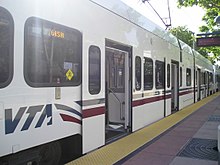VTA light rail
The VTA light rail system serves San Jose and nearby cities in Santa Clara County, California.
It is operated by the Santa Clara Valley Transportation Authority (VTA) and has 42.2 miles (67.9 km) of network comprising three main lines on standard gauge tracks.
The light rail system has been criticized for being one of the least used in the United States (an average of 370 boardings per mile on weekdays, Q3 2024) and the most heavily subsidized ($9.30 per passenger trip).
All the lines and the corridors they run through are designed to move passengers from the suburban areas of Santa Clara Valley into the major business areas in Downtown, the Santa Clara County Civic Center, and northern Silicon Valley, site of many high-tech company offices.
"[17]Santa Clara County began planning for a light rail system in the mid-1970s,[18] after the successful development of the San Diego Trolley and amid a surge in light rail construction in mid-sized cities nationwide (Buffalo, Denver, Portland and Sacramento also built systems at the same time).
[20] The operation of the line and some of the construction costs would be funded by a half-cent sales tax for a transit district voters in Santa Clara county had approved in 1976.
The light rail proposal was championed by County Supervisor Rod Diridon Sr. and Congressman Norman Mineta.
[21] The first phase, then called the Guadalupe Line, broke ground in October 1986 and opened for revenue service on time[22] on December 11, 1987, running between Old Ironsides station (near the Great America theme park and Silicon Valley office parks) and a temporary Civic Center station at First and Younger (near the junction to VTA's Guadalupe Division rail yard on Younger).
The third phase opened on August 17, 1990, extending rails into the median of California State Route 87 (Guadalupe Freeway) to Tamien station, adding the first connection to Caltrain.
Originally projected to be completed in late 1988, it was delayed for a two-year review and opened on April 25, 1991, with a scaled-down interchange between State Routes 85 and 87 and more sound walls.
[23][25][22] The system's first major expansion, Tasman West, opened in 1999, extending the rails from the northern end of the Guadalupe line to Mountain View.
The Capitol Expressway extension would have extended the system 8 miles (13 km) south from Alum Rock station to Capitol station,[29] the second phase of the Vasona extension would have extended the system 1.5 miles (2.4 km) south from Winchester station to the line's namesake Vasona Junction, and the Santa Clara / Alum Rock extension would have added 4 miles (6.4 km) of track along the busy Santa Clara Street.
Ten people, including the gunman, were killed during the shooting, the deadliest in the history of the San Francisco Bay Area.
They found that the VTA served 24.3 passenger trips per revenue hour, making it the second least effective transit system of the group.
The Grand Jury also found that VTA had failed to “accurately estimate the ongoing operating and capital costs of maintaining the light-rail system,” concluding that that failure, “has led, in part, to (the agency's) recurring financial deficits.” The VTA has said that the operating costs could be cut in half and farebox recovery doubled if a bus-only system were deployed.
Along much of the light rail routes, trains do not serve densely populated areas but instead run past single-story office buildings, single-family homes and empty lots.
Both Liccardo and O’Neill have advocated for replacing light rail with alternative technologies, like autonomous electric buses, that could be less expensive to operate.
At the time of the accident, trains were operating on a single track through the area because of construction at three nearby light rail stations.
[64] An investigation indicated human error ("the train traveling southbound stopped over the switch and reversed, which are violations of operating rules").
[34] As a result of the shooting, service was suspended indefinitely across the light rail system[35] and returned in stages throughout August and September.
Service may be extended along the Mayfield Cutoff and Vasona Industrial Lead to connect the western segments of the system.
[50] Tracks will lay on an elevated median starting just south of Alum Rock station before becoming at-grade near the end of the extension.
The Grand Jury recommended the VTA board to abandon the extension because the project would attract approximately 611 new riders (after considering the reduction in ridership on the existing parallel bus lines).



